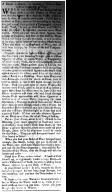[ A Receipt to Ferment Any Quantity of Wort or Flour with a Teaspoonful of Yeast ]
Date: 1780/09/12
Source:
Nova Scotia Gazette and the Weekly Chronicle
Institution: Nova Scotia Archives
| Source Origin: Nova Scotia Newspapers on Microfilm
| Reference: Consult the Nova Scotia Archives' "Nova Scotia Newspapers on Microfilm" list (Royal Gazette) for a complete account of microfilm reels for this paper. EMMR includes recipes from Microfilm Reels 990, 8155, 8156, 8158, 8162
Instructions for using small amounts of yeast in brewing beer and baking bread. Vol 10, No. 745. Microfilm Reel 8158.
A Receipt to ferment any Quantity of Wort or Flour
with a Teaspoonful of Yeast.
WHEN you have boil’d and drained off the
Hops from your first Copper of Wort, put
two or three Quarts of it in some Vessel, where it
may ly thin, in order to cool quick: You’ll find it,
in about an Hour, more or less according to the Sea-
son, just warm, then put in it a Teaspoonful of thick
steady Yeast. In two or three Hours, you’ll find it
come to a head: by this time you have more Wort
cool’d. Now put your two or three Quarts, thus
a little in Ferment, into four or five Gallons Wort,
which will bring that also to a head, or as it is call’d,
to be ripe, in the Space of two or three Hours more.
Then add these to a Hogshead of Wort, and all
will soon be ripe, by Virtue of the first Teaspoon-
ful only.
Suppose you are to bake a Bushel of Flour, put
the Flour into your kneading Trough; put to it three
Quarters of a Pint of warm Water, a Teaspoonful
of thick steady Yeast.--then make a hole in the
middle of your flour large enough to hold two gallons
of water; pour in your small Quantity, stir into it with
a stick some of the Flour, until it be of the thick
ness of Batter for a Pudding. Strew some Flour over
that Batter--so leave it for about an Hour, now it
will be raised, so that it will break through the dry
Flour. Pour in a quart more of warm Water--stir
in some more Flour, until it be as thick as before;
again shake some dry Flour over it, leave for two
Hours more--it will then rise and break through
the dry Flour again--then add three Quarts or a
Gallon more of warm Water, repeating the same
Operation. You may in about three or four Hours
more mix up your Dough--then cover it Warm. In
four or five Hours more you may put it into the Oven,
and you will have Bread as light as if you had used
a pint of Yeast. It does not take above a Quarter
of an Hour more than the usual Time of baking.
Put on your Flour, about 6 or 7 o'clock in the
Morning, your small quantity of yeast and water
as directed; in an hour's Time some more, in two
Hour a greater Quantity, about noon make up your
Dough, about six in the afternoon it will be ready
for the Oven. Thus you will have good bread nei-
ther heavy or bitter.
When you find your Body of Flour spunged large
enough, you should, before you put in the rest of
the Water, mix with both Hands that which is spun-
ged and the dry Flour altogether; then add the Re-
mainder of the Water, thus the Dough will rise the
better and easier.
Yeast is to Flour, as fire to fuel: A spark of Fire
blow’d up, will gradually kindle a large Heap--so
will a Thimbleful of Yeast, by artfully adding warm
Water, raise or spung any Body of Flour.
Is your Bread heavy? It is so, because the Body
raised or spunged has not been large Enough, but
was made up, and put into the Oven before it was
ripe.
In Summer let your Water be blood warm only;
but in Winter the Water must be as warm as your
hand without smarting can bear. Cover also your
Dough very warm in Winter.
Download: Transcription | Images
